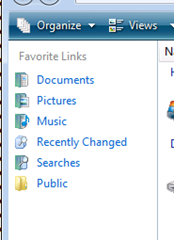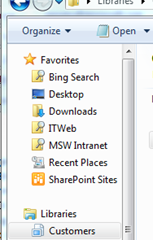LINKS! USMT 4 forgot my LINKS!!
Gary here, and in this post I am going to talk about USMT and the Links folder not migrating from Vista or Windows 7. This folder is new starting with Vista so it would not be an issue coming from XP to the higher versions of Windows.
In case you are wondering what the Links folder is, it is the Favorite Links or Favorites for Explorer.
It also corresponds to the %userprofile%\Links folder with in the user’s profile.
If you are using the migdocs.xml file, it uses the GenerateDocPatterns helper function to go collect most of the user profile folders. It is also worth noting that the miguser.xml file also has the same issue, but use of that file is discouraged regardless. The following table lists the profile folders gathered from each user’s profile directory as documented at “Migration XML Files” site for USMT.
Variable |
Migdocs.xml |
Miguser.xml |
Description |
CSIDL_MYDOCUMENTS -or- CSIDL_PERSONAL |
X |
X |
In Windows Vista or Windows 7, the virtual folder representing the My Documents desktop item. |
CSIDL_MYPICTURES |
X |
X |
The file-system directory that serves as a common repository for image files. A typical path in Windows XP is C:\Documents and Settings\username\My Documents\My Pictures. A typical path in Windows Vista or Windows 7 is C:\Users\Username\Pictures. |
FOLDERID_OriginalImages |
X |
|
The file-system directory that servers as a common repository for Windows Photo Gallery original images. A typical path in Windows Vista or Windows 7 is C:\Users\Username\AppData\Local\Microsoft\Windows Photo Gallery\Original Images |
CSIDL_MYMUSIC |
X |
X |
The file-system directory that serves as a common repository for music files. A typical path in Windows XP is C:\Documents and Settings\User\My Documents\My Music. A typical path in Windows Vista or Windows 7 is C:\Users\Username\Music. |
CSIDL_MYVIDEO |
X |
X |
The file-system directory that serves as a common repository for video files. A typical path in Windows XP is C:\Documents and Settings\username\My Documents\My Videos. A typical path in Windows Vista or Windows 7 is C:\Users\Username\Videos. |
CSIDL_FAVORITES |
X |
X |
The file-system directory that serves as a common repository for the user's favorites. A typical path in Windows XP is C:\Documents and Settings\username\Favorites. A typical path in Windows Vista or Windows 7 is C:\Users\Username\Favorites. |
CSIDL_DESKTOP |
X |
X |
The virtual folder representing the Windows desktop. |
CSIDL_QUICKLAUNCH |
X |
X |
The legacy Quick launch folder |
FOLDERID_Contacts |
X |
|
The file-system directory that serves as a common repository for the user's contacts. A typical path in Windows Vista or Windows 7 is C:\Users\Username\Contacts. |
FOLDERID_Libraries |
X |
|
The file-system directory that serves as a common repository for the user's libraries. A typical path in Windows Vista or Windows 7 is C:\Users\Username\AppData\Roaming\Microsoft\Windows\Libraries. |
FOLDERID_Downloads |
X |
|
The file-system directory that serves as a common repository for the user's downloads. A typical path in Windows Vista or Windows 7 is C:\Users\Username\Downloads. |
FOLDERID_SavedGames |
X |
|
The file-system directory that serves as a common repository for the user's saved games. A typical path in Windows Vista or Windows 7 is C:\Users\Username\Saved Games. |
CSIDL_STARTMENU |
|
X |
The file-system directory that contains Start menu items. A typical path in Windows XP is C:\Documents and Settings\username\Start Menu. A typical path in Windows Vista or Windows 7 is C:\Users\Username\AppData\Roaming\Microsoft\Windows\Start Menu. |
As you see, the list above does not include anything indicating the Link folder would be touched. To gather and restore the LINKS folder you can use the following sample. Please do not modify the migdocs.xml (or miguser.xml) file as you can easily include the additional XML file in the command line. In addition, it would prevent any potential conflicts if newer versions are released and overwrite your hard work.
scanstate.exe c:\store /i:migapp.xml /i:migdocs.xml /i:miglinks.xmlloadstate.exe c:\store /i:migapp.xml /i:migdocs.xml /i:miglinks.xml
<?xml version="1.0" encoding="utf-8" ?>
<!--Sample - migrates user Links (aka quicklaunch) folder from Vista/7 to Vista/7-->
<!--This code is NOT necessary when going from XP to Vista/7 -->
<migration urlid="https://www.microsoft.com/migration/1.0/migxmlext/migratelinks">
<component type="Documents" context="User">
<displayName>Migrate Links Folder</displayName>
<role role="Data">
<rules>
<include>
<objectSet>
<pattern type="File">%CSIDL_PROFILE%\Links\* [*]</pattern>
</objectSet>
</include>
</rules>
</role>
</component>
</migration>
With the use of the above information, you will be able to preserve the user’s Links folder from Vista/7 to Vista/7 migrations.
Happy link migrations!
Gary “look, a USMT post from someone besides Ned is possible” Mudgett

